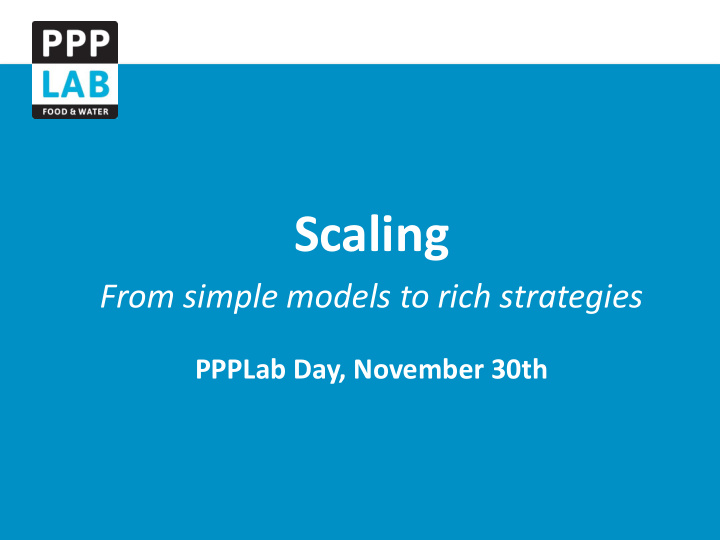



Scaling From simple models to rich strategies PPPLab Day, November 30th
Scaling: recent publications Insight Series Tool Animation
The rationale for scaling As the SDGs require transformational change, scaling can provide: Reaching more people Higher efficiencies Achieving system change
I. Delivery mechanism II. Horizontal and vertical strategies III. How: ten ‘ingredients’ IV. Two types of stages V. Financing scaling
I. Delivery mechanism
What is scaled? What is scaled is not so much the technical solution (only) but rather delivery mechanism(s) for a range of elements* that enable the adoption and sustainability of the improved solution or practice. * Technology, finance, (support) services, knowledge etc.
Delivery mechanisms: options • Commercial firms and outlets (shops, agro-dealers) • Public or collective infrastructure (markets, warehouses) • Organisations of users/producers • Intermediary actors, such as NGOs • Local govt. mechanisms (incl. extension services etc.) • Brokering, facilitation, advisory services, hubs • Phone/web-based outreach (sites, apps, sms services)
A strong delivery mechanism Delivers combination of elements for sustainable use* Connects to optimum number of users Acts as motor, driven by lead actor or lead collaboration Balances standardization and responsiveness to context Enables horizontal replication & vertical linkages * Technology, finance, (support) services, knowledge, etc.
II. Horizontal and vertical scaling
Horizontal and vertical
Scaling barriers • Inhibitory laws • Lack of market • Lack of • Weak business and regulations information and model labour/inputs • Inhibitory taxes • Weak • Weak sourcing industry and subsidies knowhow proposition channels from • Adverse • Absence of • Weak BoP • Weak intervention by standards management • Lack of hard • Lack of capital politicians distribution infrastructure channels • Lack of service providers
Horizontal and vertical scaling VERTICAL HORIZONTAL Primary Increasing numbers and Improving the enabling orientation business growth environment and institutions • Demand, awareness • Value chain governance • Quality of the solution • Sector platforms Related areas of • Attractive and efficient • Public policies and action business regulations • Value chain development • Tertiary chain/sector functions
III. How do you scale? 10 ingredients
How: scaling ingredients
IV. Two types of scaling stages - Stages of horizontal scaling - Stages of vertical scaling
Horizontal: stages of scaling a business proposition (after Koh et al. 2012)
Vertical: stages of sector transformation (after NewForesight Consultancy B.V.)
V. Financing scaling Graduation - ‘from aid to trade’
What is funded by whom and why? Develop your finance strategy connecting all phases
Finance – graduation
Financing across vertical stages • From public/grant to commercial money • Think about financing of next stages! • 1 st movers create (new) financing arrangements • Financing environment critical for real scale • Options very specific for (sub-)sectors
Case(s)
Roles of PPPs in scaling
Case 1: Aquaculture, Kenya Larive – FoodTech Africa FDOV: Africa Sustainable Food Production Kenya / East Africa
Case 2: Sugar, India “INCREASING WATER USE EFFICIENCY IN SUGARCANE CULTIVATION IN INDIA” € 4.828.774 (50% NL MoFA) (2014-2019) Lead actors: * Solidaridad (NGO), * 3 sugar mills, * Vasantdada Sugar Institute, * Osmania University, * eLEAF (tech firm) * Hindustan Unilever Foundation Results: 35,000 farmers trained, 300 micro- entrepreneurs trained in support services, renewed extension services of 3 mills. Water consumption per acre reduced by 16%, water productivity increased 33%, viable business cases for farmers, mills and micro-entrepreneurs. Scaling and system change: Strong business case, empowers ‘first movers’, effective vehicle (firms+NGOs), produces proof of concept, pursues a sub- sector platform, used to influence policy issues, builds knowledge institutes. Vertical scaling stage: first movers.
Case 3: Coffee, Colombia “INTELLIGENT WATER MANAGEMENT IN COLOMBIA” (2012-2017) € 20.500.000 - 50% NL ODA, 35% business, 15% Col. Ministries Lead actors: * Federacion National de Cafetores de Colombia (FNC) (NGO/PO), * Nestlé, Nespresso (firms), 2 Colombian ministries, Wageningen UR (K) Results: Water & Coffee Platform, learning network operating, covering 5 depts, 25 muni. Realised: 25 basin mgt plans, 75.000 producers + 1000 profs trained, 4700 on-farm impr. plans, 300 waste water systems, 25 measurement stations. Positive ec. returns for farmers, coffee firms and tech providers. Scaling and system change: Cross-sector platforms are scaling mechanisms in themselves, building on historical politics and platforms. Revitalises IWRM (public good & task). 33 additional partners joined. Govt. shifts funding. Interests in replication to other regions, countries. Vertical scaling stage: first movers to critical mass.
Questions?
The Scaling Scan
Scaling: recent publications Tool Insight Series
The three steps of the Scaling Scan Define the scaling ambition and delivery mechanism Assess the ingredients of your scaling strategy Formulate implications
The Scaling Scan Technology 5 Data, ICT and M&E Business case 4 3 Knowledge and Awareness and 2 skills demand 1 0 Leadership and Finance management Public sector Value chain governance development Platforms and collaboration
Scoring the ingredients Interpretation of the scores: 1 = Very poor, uncertain, unknown 2 = Major challenges, major risk for failure 3 = Some grip, significant improvements needed 4 = Good grip, some improvements desirable 5 = More or less under control / up to standards
Questions and discussion
Some key takeaways Don’t overestimate the stage you are in Competitive analysis: are you a 1 st mover? Scaling and system change need many ingredients How strong and replicable is the delivery mechanism? Have a vision on financing the next phase
End Thank you
Recommend
More recommend